
Coastal cities in Virginia and around the world are increasingly turning to seawalls to protect residents from flooding that’s worsening due to climate change.
But at the same time, climate change could weaken the effectiveness of those seawalls. Officials need to know more about how and why as they build new infrastructure meant to last well into this century, said Sherif Abdelaziz, an associate engineering professor at Virginia Tech.
Many existing seawalls were built 50 or more years ago — and they’ve started to sink or shift in place, he said.
“A simple example to look at is the Pisa tower — it was not built to be leaning,” Abdelaziz said. Like the tower in Italy, “retaining walls can move inward, backward, settle, rotate.”
But he said some of these walls are moving more than engineers expected when they designed and built them decades ago.
Abdelaziz is part of a research team studying why. They believe warmer weather and flooding driven by climate change could make seawalls less stable long-term.
“So the hypothesis is that when the temperature increases due to climate change, you'll actually see some significant increase on the pressure on the walls,” he said.
Repeated wetting and drying cycles over time as waves wash over the seawalls could also have an impact.
Inside a building on the Blacksburg campus, the team is using a concrete research wall to test whether that’s true. It’s about 8 feet tall and 20 feet wide.
Abdelaziz said the process will take several years. First they’ll test the dry soil around the wall at room temperature as a baseline. Then they’ll slowly increase temperature and add in water to simulate flooding. Sensors embedded in the walls and soil provide data on how everything responds.
“We basically start adding one ingredient at a time so we can understand how each one of them is impacting the other.”
A seawall can refer to a range of things – a small retaining wall guarding the shoreline of a private property, or something like the massive, 8-mile floodwall Norfolk plans to build wrapping around downtown.

A section of Norfolk's existing floodwall downtown, built by the Army Corps in 1971. It will be expanded and heightened as part of the new project.
Norfolk’s floodwall and several others planned along the East Coast – including in Charleston, Miami and New York – are part of a federal Army Corps of Engineers initiative formed after Hurricane Sandy.
Historically, temperature has not been part of the engineering design parameters for seawalls, Abdelaziz said.
The Army Corps has helped fund research on Virginia Tech’s retaining wall with more than $20 million across several projects, he said. He hopes that means the Corps might use the findings to revise its design manuals.
The new project also includes researchers from across the pond. Virginia Tech is working with Heriot-Watt University in Edinburgh, Scotland. The U.K. counterparts will do laboratory testing that simulates climate change scenarios, to complement the wall experiments in Virginia.
Abdelaziz said the goal is to not only identify problems, but also develop solutions for better coastal infrastructure.
“Now I think we have our eyes open on the impact in the next 100 years. We don't want our kids and grandkids to go through what we're going through now,” he said. “So we have this very, very clear in our vision. Yes, engineers construct things, but we also look for ways to improve the way we construct it. So just stay tuned.”





